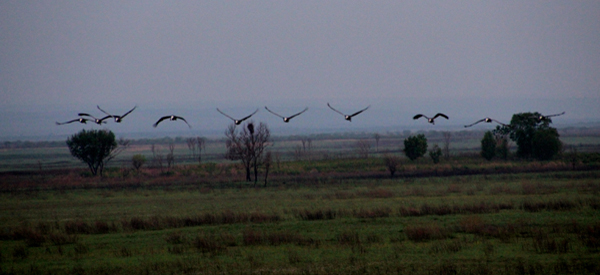 At dawn, White-naped Cranes fly from their roosting area on wetlands within Muraviovka Park to agricultural fields where they forage on gleanings from last year’s crops. |
| By Dr. George Archibald, ICF Co-founder In early June as the sun peeped over the horizon about 6:00 a.m. to brighten the distant hills of China, White-naped Cranes lifted from the early morning mists that often cover the great marshes of Russia’s Muraviovka Park. They flew silently into the light to reach a last year wheat field on the elevated terrace near the headquarters of the Park, to feed on leftover grain. There were usually between 60 to 90 cranes (a mixed flock of mostly White-naped, but also Hooded, Eurasian and Red-crowned Cranes) including as many as 11 juveniles whose brown napes indicated their hatch year as 2011. There were also pairs that perhaps included birds hatched in 2010 as well as older cranes whose nesting attempts had failed. Pairing and a well established pecking order seemed established and reinforced by loud unison calls, exaggerated walking, various threat postures and dancing. They foraged, displayed, and rested for between one and two hours before flying in small groups back to the wetlands and grasslands within the borders of the 16,000-acre Park spread across the floodplain of the world’s longest undammed river, the Amur, that defines the international border between China and Russia. Later in the afternoon the cranes returned to the fields to feed before flying to a distant roosting area of shallow water where they become grey dots in my telescope as the sun disappears into China. 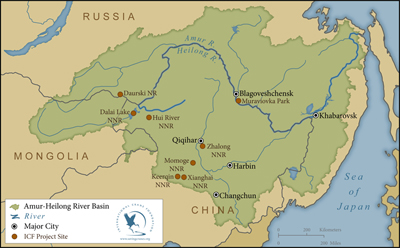 The wetter areas of the Park provide safe nesting habitat for both White-naped and Red-crowned Cranes. The cranes make low platform nests from reeds, roots and mud, and each pair usually lays a clutch of two eggs that hatch after about a month of incubation. As many as several hundred acres are vigorously defended against the intrusion of other cranes of that pair’s species. However, breeding territories of these two species often overlap, presumably because the diet of the White-naped Crane – insects, seeds, roots, tubers, as well as grain in agricultural fields — does not overlap that of the Red-crowned Crane that feeds primarily on fish and other aquatic animals. Dr. Sergei Smirenski, the founder and president of the Park, also told me that throughout the incubation and chick rearing period, White-naped Cranes often feed in agricultural fields, whereas Red-crowned Cranes always remain in wetlands until chicks are fledged. 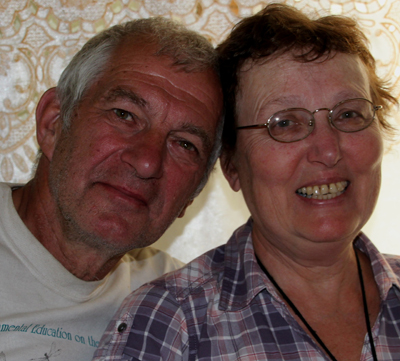 In early April as the cranes returned from their wintering grounds in Japan and Korea, a Japanese ornithologist Dr. Tamaki Kitagawa also migrated to the Park to resume studies of cranes that he started the previous spring. Tamaki-san and I have been close friends since sharing winter and spring camping in 1972 when we studied Red-crowned Cranes in northern Japan. When he retired in 2009 from teaching high school biology, he spent the full year of 2010 studying cranes at ICF headquarters in Wisconsin where he came to know Sergei and his wife Elena, a full time employee at ICF. Sergei is also a migrant to the Park, spending parts of the year at ICF for writing and fund raising. Last year, Tamaki located 14 pairs of White-naped Cranes and three pairs of Red-crowned Cranes nesting in the Park. This year there are 20 pairs of White-naped and 2 pairs of Red-crowned, with a third pair of Red-crowned Cranes perhaps breeding just outside the Park. In addition, there are two non-breeding pairs of Red-crowned Cranes that show promise of breeding next year. As wetlands elsewhere on the mainland of Asia are heavily impacted by drought and human activity, Muraviovka Park remains a bastion of stability for wetland and grassland conservation. And as a reflection of that security, its crane populations are increasing! 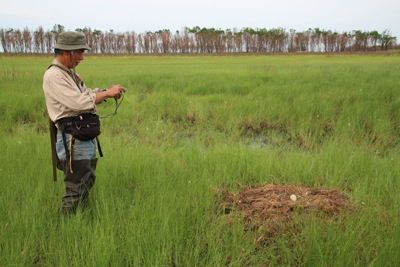 In Russia there are typically two types of protected areas: strictly protected areas (zapovedniks) and wildlife refuges (zakazniks). Without official permission, humans are not permitted to enter zapovedniks. Each zapovednik has a staff including researchers, administrators and wardens. In contrast, access to zakazniks is allowed for recreation and sometimes for hunting and fishing. Unfortunately, since perestroika in 1991, conservation programs at many protected areas are inadequately funded and encroachment and hunting sometimes occur. In 1993, Sergei dreamed of a privately protected area to include both agricultural and wilderness landscapes where environmentally-friendly agricultural practices and sound nature conservation could be demonstrated side-by-side, and where visitors could freely come to experience the wonders of nature. That dream became a reality in 1994 when a Japanese corporation Pop International provided funds to lease for a half-century, 12,850 acres of wetlands and wet meadows to create the first private nature reserve in Russia. Later some arable land acreage was added and today the Park has grown to include ~13,500 acres of natural habitat and ~2500 acres of cropland, with income from the latter providing major support for operations. 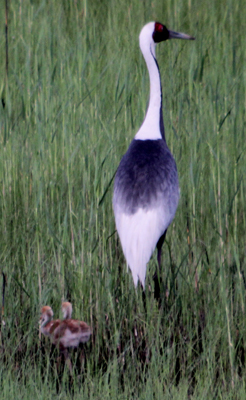 The Park is governed by a Board of Trustees that currently includes five Russians, two Japanese, one Chinese, and five people from the USA. Sergei and Elena Smirenski, Jim Harris (ICF’s Senior Vice President) and I are members and Eliza Klose, a Russian conservation specialist from Connecticut, is the Chair. There is also a Board of Advisors with three Russian, one Japanese, and one American member. On our way to share an expedition in Mongolia with a group of members of ICF, a Director of ICF from California, Dr. Margery Nicolson, and I spent a week in early June at Muraviovka Park with the Smirenski couple and Tamaki. Having heard Jim and I speak so fondly about the Park for many years, Margery wanted to see it for herself. And of course, it is always a great joy for me to experience springtime in crane country.As well as arranging excursions to various parts of the park to observe a plethora of wild flowers and wildlife, the Smirenski couple introduced us to prominent citizens from the nearby city, Blagoveshchensk, four of whom accepted invitations to join the Board of Trustees of the Park. During the past years, the Board has drafted a Strategic Five Year Plan for the Park, a plan that calls for increased income to support growing programs in wildlife and hydrological research and public education. The plan also calls for increased involvement of more Russians on the Board of Trustees. Both of those objectives are being realized in 2012, as about 600 more acres of fallow agricultural land are being prepared for crops, and as prominent Russians become more involved. And with support from individuals in the USA for two years, Sergei hopes to employ a full time site manager to supervise the farming program and to maintain the facilities and lands. In the not-too-distant future we hope that the Park will be self-sustaining. Muraviovka Park is but one of the many projects that ICF has helped create and nurture, a process that requires years of effort and unbridled optimism. When I feel impatient, I think about a fertile egg that requires a long and delicate incubation period before a chick hatches. Such a process cannot be rushed. A proper environment must be assured. And even after hatching there is a long period of growth before fledging. We anticipate Muraviovka Park will be successfully fledging perhaps within the next half-decade. In the meantime, the crops and chicks are growing in a far-away place in eastern Siberia where a small cluster of dedicated humans strive to find that elusive win-win for man and nature, an outcome with wide application across Russia and beyond. |
